


Published articles present details the instrument’s capability and specification:
For remote user experiments, please visit the User Guide to Remote Experiments webpage.
Shipping Addresses for Samples
For details information, please visit the ORNL User Facilities Sample Handling and Shipping page.
Non-activated samples coming to HFIR:
Recipient: IPTS XXXXX, HFIR user sample
Oak Ridge National Laboratory / HFIR Site
1 Bethel Valley Road
Bldg 7972 Room 100 [Special requirements (example: freezer or intert gas)]
Oak Ridge, TN 37830
HFIR Sample Management Desk phone number: 865-576-9030
Activated samples coming to HFIR:
Recipient: IPTS XXXXX, HFIR user sample [Replace the XXXX with your IPTS number]
Oak Ridge National Laboratory / HFIR Site
1 Bethel Valley Road
Bldg 7001 [Special requirements (example: freezer or intert gas)]
Oak Ridge, TN 37830
HFIR Sample Management Desk phone number: 865-576-9030
Users are encouraged to use a shipping provider who delivers directly to ORNL (ex: FedEx, UPS, DHL). These shipments are considered priorities and are processed through ORNL shipping facilities within 8-24 hours of delivery. Please be aware that the use of USPS may delay the processing of your shipment. due to a longer lead time for sorting.
NOTE: Replace the XXXX with your Integrated Proposal Tracking System (IPTS) number.
Software Downloads
Data is accessed and reduced remotely on the SNS analysis cluster using Mantidworkbench. A good tool to obtain an overview of your measured files is through ONCat.
The data reduction process has changed in 2021. Please refer to the following manuals for data reduction:
Lecture Notes and Example Data
Please refer to the Lecture Notes page from the Magnetic Structure Determination from Neutron Diffraction Data Workshop 2016 for example data and relevant articles.
Oak Ridge National Laboratory is managed by UT-Battelle LLC for the US Department of Energy